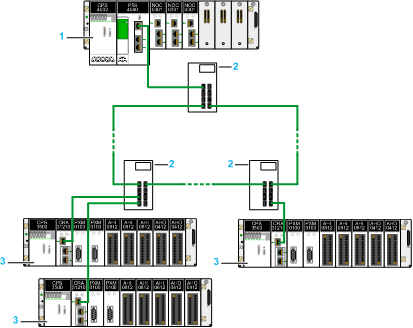|
System Performance
|
|
|
Original instructions
|

1M580 CPU with RIO scanner service in the local rack
2Industrial Ethernet managed switch
3X80 RIO drop with BM•CRA312•0 X80 EIO adapter module.
|
Parameter
|
Description and formula
|
Maximum value (ms) for the M580 open architecture example
|
|
|---|---|---|---|
|
CRA_Drop_Process
|
BM•CRA312•0 processing time
CRA_Drop_Process = The sum of BM•CRA312•0 input scan time and queue delay.
|
CRA_Drop_Process = 4.4
|
|
|
RPI
|
BM•CRA312•0 input RPI value is depending to the defined CPU task
Default values are:
|
RPI = 0.5 * 50 = 25
|
|
|
Network_In_Time
|
Network input time
Network_In_Time = (network delay based on I/O packet size) * (the number of hops(1) the packet travels)
|
Network_In_Time = (0.078 * 4) = 0.312
|
|
|
I/O packet size (bytes):
|
Estimated network delay (μs):
|
||
|
128
|
26
|
||
|
256
|
35
|
||
|
400
|
46
|
||
|
800
|
78
|
||
|
1200
|
110
|
||
|
1400
|
127
|
||
|
Network_In_Jitter
|
Network input jitter is the delay occasioned by devices
Network_In_Jitter = [(network delay) * (number of RIO drops)] + [(network delay) * (number of distributed equipment hops(1))]
|
Network_In_Jitter = (0.078 * 3) = 0.234
|
|
|
CPU_In_Jitter
|
CPU Ethernet I/O scanner service input jitter: CPU input queue delay (owing to RIO drops and DIO traffic) to read packet.
CPU_In_Jitter = (1 + (0.07 * (number of RIO drops))
|
CPU_In_Jitter = (1 + (0.07 * 3)) = 1.21
|
|
|
CPU_Scan
|
CPU scan time
User defined, based on application.
|
CPU_Scan = 50
|
|
|
CPU_Out_Jitter
|
CPU Ethernet I/O scanner service output jitter: CPU output queue delay (owing to RIO drops).
CPU_Out_Jitter = (1 + (0.07 * (number of RIO drops))
|
CPU_Out_Jitter = (1 + (0.07 * 3)) = 1.21
|
|
|
Network_Out_Time
|
Same formula as network input time
Network_Out_Time = (network delay) * (the number of hops(1) the packet travels)
|
Network_OUT_Time = (0.078 * 4) = 0.312
|
|
|
Network_Out_Jitter
|
Same formula as Network input jitter without I/O frames from RIO drops
Network_Out_Jitter = (network delay) * (number of distributed equipment hops(1))
|
Network_Out_Jitter = 0
Does not apply. No distributed equipment is connected to the RIO network.
|
|
|
CRA_Drop_Process
|
BM•CRA312•0 process time
CRA_Drop_Process = The sum of the BM•CRA312•0 X80 EIO adapter module output scan time and queue delay
|
CRA_Drop_Process = 4.4
|
|
(1)The maximum potential hop count, which represents the maximum number of switches a packet might pass through from the adapter module BM•CRA312•0 to the CPU. This count includes the switches in both the BM•CRA312•0 X80 EIO adapter module and the CPU with Ethernet I/O scanner service. |
|||